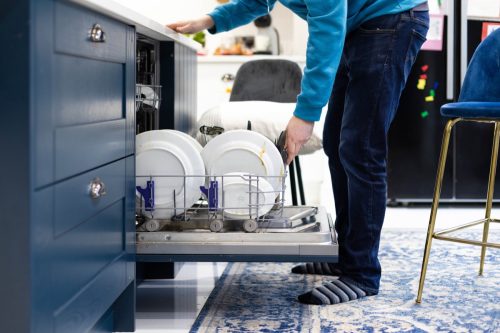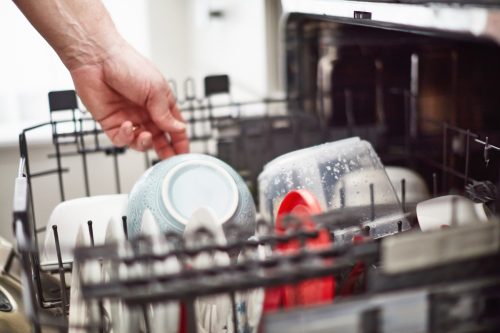Putting Plastic in the Dishwasher? Why It Should Never Go on the Bottom Rack

Having a dishwasher can certainly help you cut down the time you spend cleaning. You can load your dirty dishes and let your machine take over from there, seemingly eliminating the need for you to hand wash anything—right? If you have plastic products that need to be cleaned and no space left on the top rack, you might want to wash these by hand or wait for the next cycle. After all, experts say plastic should never go on the bottom rack of your dishwasher. Read on to find out exactly why this is an issue.
READ THIS NEXT: What Happens When You Don’t Wash Your Sheets Every Week, Doctors Say.
People are pretty set in their ways when it comes to dishwashing.

People in the U.S. definitely don’t shy away from using their dishwashers. A 2022 survey conducted by OnePoll on behalf of LG Electronics found that at least half of us run our dishwashers at least three times a week. And people seem pretty set in their ways when it comes to exactly how they use their dishwasher—particularly when it comes to where they’re putting certain dishes, according to the survey.
In terms of the bottom rack, 75 percent said this is where plates belong, while 67 percent said the same for cutlery utensils, 55 percent for pots and pans, and 37 percent for fine dining ware. On the other hand, 76 percent said they save the top rack for coffee mugs, while 74 percent said the same for glasses, 62 percent for travel mugs, 52 percent for plasticware, and 43 percent for bowls.
“When it comes to the kitchen, we know that people are passionate about their cooking and cleaning habits,” Angela Gozenput, director of brand marketing for LG Appliances, said in a statement. “We’re seeing a more relaxed notion around doing dishes and an increase of people trusting their machines to not ruin even their more beloved dishes. Yet there’s still room for controversy on the ‘right’ way to do things.”
But experts say plastic should never go on the bottom rack.

While people may disagree on the “right” way to load the dishwasher, the 52 percent of respondents who said they reserve the top rack for their plasticware are following what experts advise. “As a rule of thumb, plastics should not be placed on the bottom rack of your dishwasher,” says Alex Varela, the general manager of Dallas Maids, a house cleaning service in Dallas, Texas.
Varela says the main reason is the high exposure to heat in this location. “Dishwashers use extremely hot water to sanitize and melt grease,” he explains. “The bottom rack is the one closest to the heater, which is why you should not place plastic items there.”
For more cleaning advice delivered straight to your inbox, sign up for our daily newsletter.
This can damage your plasticware.

If you do put plastic on the bottom rack, you may end up destroying the items. The hot temperatures “will wrap or melt” plastic, according to Varela.
This area also receives “more intense jet pressure” than the top rack, which adds to the potential damage of plastic items, according to Alessandro Gazzo, a cleaning expert with Emily’s Maids in North Dallas, Texas. “They will burn, melt, or warp, and they just won’t be functional anymore,” Gazzo explains.
But even if they aren’t destroyed completely, this placement can still negatively affect your plastic dishes, says Shirley Langridge, an appliance cleaning technician at Fantastic Services. “Besides their close proximity to the heating element and spray arm, placing plastic items in the bottom rack can also affect the washing machine’s drainage,” she adds. “They may block the drainage holes and prevent water from draining properly, causing it to pool around the items. This can lead to damage or discoloration.”
You should stop your dishwasher immediately if you make this mistake.

If you’ve already started the cleaning cycle on your dishwasher only to realize you’ve loaded plastic items on the bottom, don’t wait to take action.
“As soon as you realize your mistake, open the dishwasher and remove the plastic items from the bottom rack. This will help prevent them from melting or warping further,” Langridge advises. If they’re already heavily damaged, she says you should discard them.
You should also assess your actual machine afterward, according to Langridge. “Once you’ve removed the plastic items, clean the dishwasher to remove any melted plastic or residue that may be left behind,” she adds. “To do that, run the dishwasher empty with a cup of vinegar added to the bottom of the machine.”